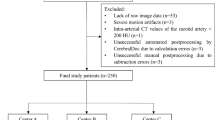Abstract
This study aimed to validate the clinically demonstrated equivalency of the axial and helical scan modes (AS and HS, respectively) for head computed tomography (CT) using physical image quality measures and artifact indices (AIs). Two 64-row multi-detector row CT systems (CT-A and CT-B) were used for comparing AS and HSs with detector rows of 64 and 32. The modulation transfer function (MTF), noise power spectrum (NPS), and slice sensitivity profile were measured using a CT dose index corresponding to clinical use. The system performance function (SPF) was calculated as MTF2/NPS. The AI of streak artifacts in the skull base was measured using an image obtained of a head phantom, while the AI of motion artifacts was measured from images obtained during the head phantom was in motion. For CT-A, the 50%MTFs were 7% to 9% higher in the HS than the AS, and the higher MTFs of HS associated NPS increases. For CT-B, the MTFs and NPSs were almost equivalent between the AS and HS, respectively. Consequently, the SPFs of AS and HS were nearly identical for both CT systems. For both CT systems, the skull base AI did not differ significantly between AS and HS, while the motion AIs of HS were significantly better than of AS. The superior motion AI in the HS indicated the effectiveness of HS on moving patients.










Similar content being viewed by others
References
Abdeen N, Chakraborty S, Nguyen T, dos Santos MP, Donaldson M, Heddon G, Schwarz BA (2010) Comparison of image quality and lens dose in helical and sequentially acquired head CT. Clin Radiol 65:868–873
Davis AJ, Ozsvath J, Vega E, Babb JS, Hagiwara M, George A (2015) Continuous versus sequential acquisition head computed tomography image quality comparative study. J Comput Assist Tomogr 39:876–881
Adult Routine Head CT Protocols Version 2.0 (2016) A web document of the Alliance for Quality Computed Tomography (AQCT) of American Association of Physicists in Medicine (AAPM). https://www.aapm.org/pubs/CTProtocols/documents/AdultRoutineHeadCT.pdf. Accessed 10 Aug 2019
ACR–ASNR Practice Parameter for the Performance of Computed Tomography (CT) of the Brain Revised (2015) (Resolution 20). https://www.acr.org/-/media/ACR/Files/Practice-Parameters/CT-Brain.pdf. Accessed 10 Aug 2019
Sodickson A, Okanobo H, Ledbetter S (2011) Spiral head CT in the evaluation of acute intracranial pathology: a pictorial essay. Emerg Radiol 18:81–91
Kim ES, Yoon DY, Lee H et al (2014) Comparison of emergency cranial CT interpretation between radiology residents and neuroradiologists: transverse versus three dimensional images. Diagn Interv Radiol 20:277–284
Zacharia TT, Nguyen DT (2010) Subtle pathology detection with multidetector row coronal and sagittal CT reformations in acute head trauma. Emerg Radiol 17:97–102
Alberico RA, Loud P, Pollina J, Greco W, Patel M, Klufas R (2000) Thick-section reformatting of thinly collimated helical CT for reduction of skull base-related artifacts. AJR 175:1361–1366
Takata T, Ichikawa K, Mitsui W, Hayashi H, Minehiro K, Sakuta K et al (2017) Object shape dependency of in-plane resolution for iterative reconstruction of computed tomography. Phys Med 33:146–151
Nickoloff EL (1988) Measurement of the PSF for a CT scanner: appropriate wire diameter and pixel size. Phys Med Biol 33:149–155
Ichikawa K, Kobayashi T, Sagawa M, Katagiri A, Uno Y, Nishioka R et al (2015) A phantom study investigating the relationship between ground-glass opacity visibility and physical detectability index in low-dose chest computed tomography. J Appl Clin Med Phys 16:202–215
Kleinman PL, Strauss KJ, Zurakowski D, Buckley KS, Taylor GA (2010) Patient size measured on CT images as a function of age at a tertiary care children’s hospital. Am J Roentgenol 194:1611–1619
Samei E, Richard S (2015) Assessment of the dose reduction potential of a model-based iterative reconstruction algorithm using a task-based performance metrology. Med Phys 42:314–323
Kawashima H, Ichikawa K, Matsubara K, Nagata H, Takata T, Kobayashi S (2019) Quality evaluation of image-based iterative reconstruction for CT: comparison with hybrid iterative reconstruction. J Appl Clin Med Phys 20:199–205
Ichikawa K, Kawashima H, Shimada M, Adachi T, Takata T (2019) A three-dimensional cross-directional bilateral filter for edge-preserving noise reduction of low-dose computed tomography images. Comput Biol Med 111:103353
Boedeker KL, Cooper VN, McNitt-Gray MF (2007) Application of the noise power spectrum in modern diagnostic MDCT: part I. Measurement of noise power spectra and noise equivalent quanta. Phys Med Biol 52:4027–4046
International Commission on Radiation Units and Measurements (1996) Medical imaging—the assessment of image quality. ICRU report No. 54. ICRU Publications, Bethesda
Hsieh J (2009) Slice-sensitivity profile and noise. In: Hsieh J (ed) Computed tomography: principles, design, artifacts, and recent advances, 2nd ed. SPIE Press, Bellingham, pp 348–354
Lin XZ, Miao F, Li JY et al (2011) High-definition CT Gemstone spectral imaging of the brain: initial results of selecting optimal monochromatic image for beam-hardening artifacts and image noise reduction. J Comput Assist Tomogr 35:294–297
Mackenzie A, Honey ID (2007) Characterization of noise sources for two generations of computed radiography systems using powder and crystalline photostimulable phosphors. Med Phys 34:3345–3357
Samei E, Bakalyar D, Boedeker KL et al (2019) Performance evaluation of computed tomography systems: summary of AAPM task group 233. Med Phys 46:e735–e756
Ichikawa K, Hara T, Urikura A, Takata T, Ohashi K (2015) Assessment of temporal resolution of multi-detector row computed tomography in helical acquisition mode using the impulse method. Phys Med 31:374–381
Author information
Authors and Affiliations
Corresponding author
Ethics declarations
Conflict of interest
The authors declare that they have no conflict of interest.
Ethical approval
This article does not contain any studies with human participants or animals performed by any of the authors.
Additional information
Publisher's Note
Springer Nature remains neutral with regard to jurisdictional claims in published maps and institutional affiliations.
Rights and permissions
About this article
Cite this article
Fujimura, I., Ichikawa, K., Miura, Y. et al. Comparison of physical image qualities and artifact indices for head computed tomography in the axial and helical scan modes. Phys Eng Sci Med 43, 557–566 (2020). https://doi.org/10.1007/s13246-020-00856-5
Received:
Accepted:
Published:
Issue Date:
DOI: https://doi.org/10.1007/s13246-020-00856-5




